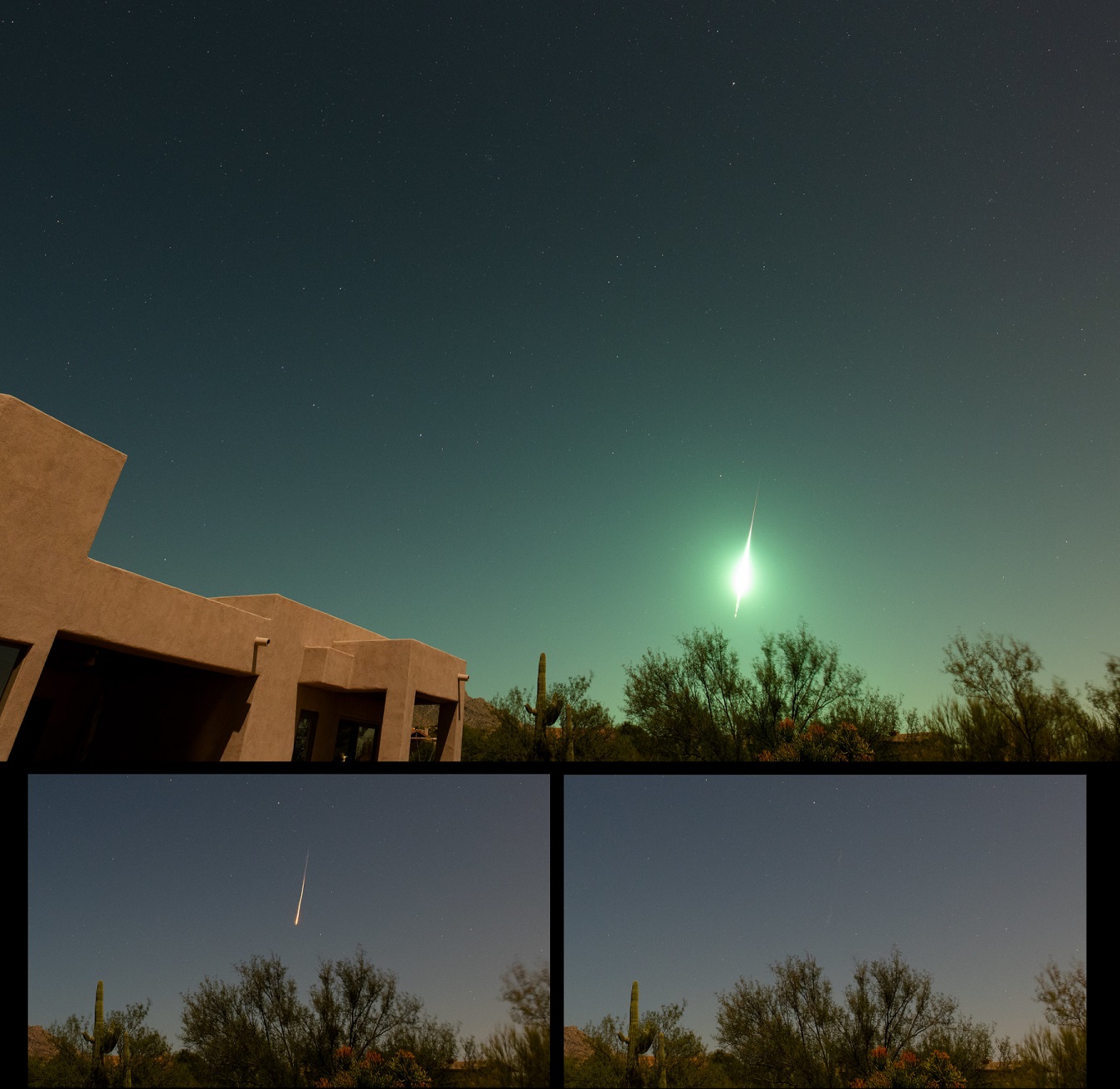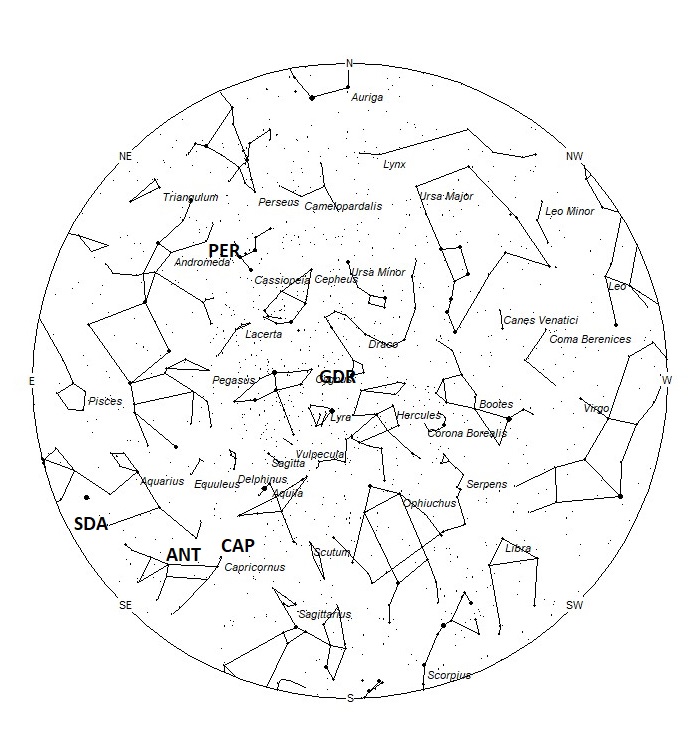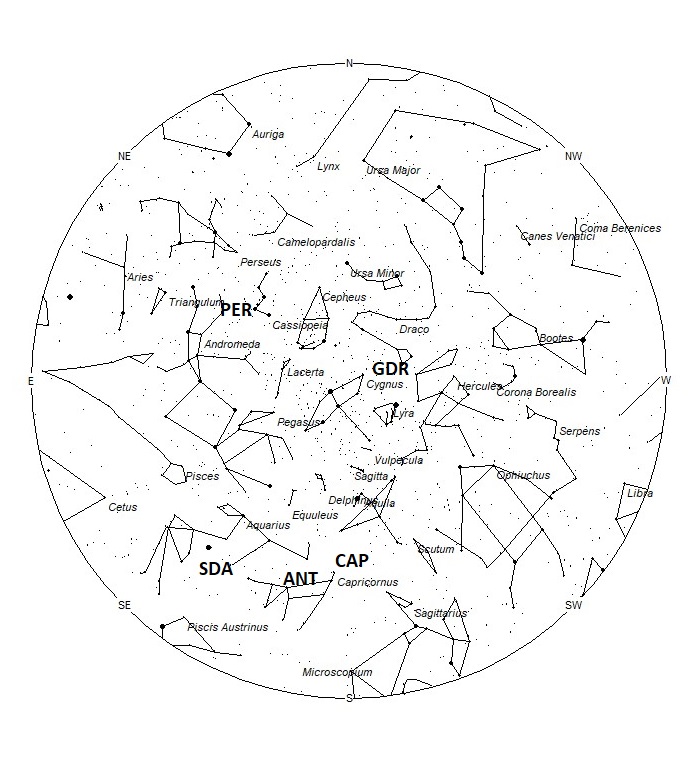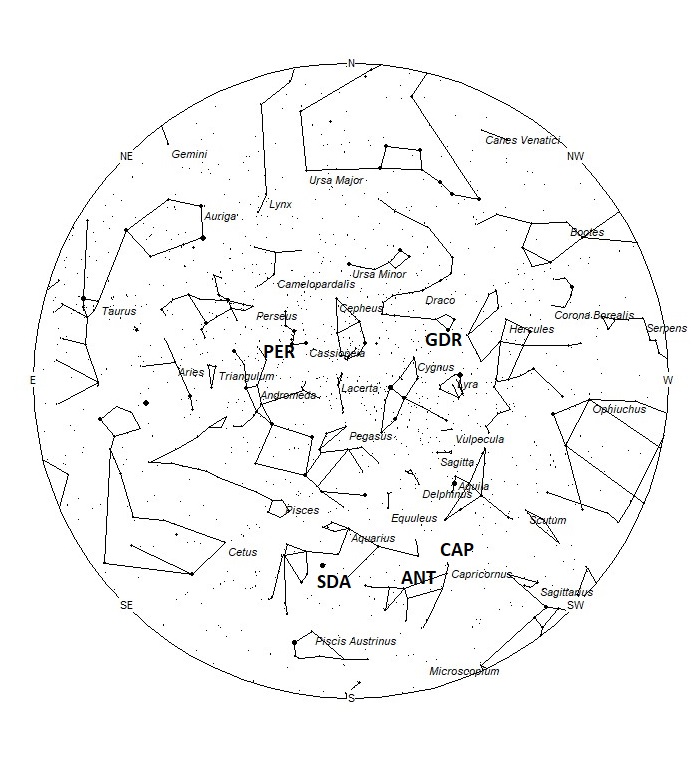 Following his capture of a bright Taurid on November 5, Eliot Herman captured another exceedingly bright Taurid fireball on November 9, 2022, at 02:17 MST (9:17 UT) from Tucson, Arizona, USA. The secondary frames display the resulting persistent train of this fireball as it fades. ©Eliot Herman
Following his capture of a bright Taurid on November 5, Eliot Herman captured another exceedingly bright Taurid fireball on November 9, 2022, at 02:17 MST (9:17 UT) from Tucson, Arizona, USA. The secondary frames display the resulting persistent train of this fireball as it fades. ©Eliot HermanDuring this period, the moon reaches its first quarter phase on Tuesday July 25th. At that time, the half-illuminated moon will set near midnight (on July 26th). This will allow the more active morning hours to be free of interfering moonlight. As the week progresses the gibbous moon will begin to encroach upon the early morning hours and will begin to interfere with meteor observations during that time. This weekend the viewing conditions will be favorable as the crescent moon will set during the evening hours and will not interfere with the more active morning hours. The estimated total hourly rates for evening observers this week should be near 3 as seen from mid-northern latitudes (45N) and 3 as seen from tropical southern locations (25S) For morning observers, the estimated total hourly rates should be near 20 as seen from mid-northern latitudes (45N) and 18 as seen from tropical southern locations (25S). Evening rates are reduced due to moonlight. The actual rates seen will also depend on factors such as personal light and motion perception, local weather conditions, alertness, and experience in watching meteor activity. Note that the hourly rates listed below are estimates as viewed from dark sky sites away from urban light sources. Observers viewing from urban areas will see less activity as only the brighter meteors will be visible from such locations.
The radiant (the area of the sky where meteors appear to shoot from) positions and rates listed below are exact for Saturday night/Sunday morning July 22/23. These positions do not change greatly day to day so the listed coordinates may be used during this entire period. Most star atlases (available at science stores and planetariums) will provide maps with grid lines of the celestial coordinates so that you may find out exactly where these positions are located in the sky. I have also included charts of the sky that display the radiant positions for evening, midnight, and morning. The center of each chart is the sky directly overhead at the appropriate hour. These charts are oriented for facing south but can be used for any direction by rotating the charts to the desired direction. A planisphere or computer planetarium program is also useful in showing the sky at any time of night on any date of the year. Activity from each radiant is best seen when it is positioned highest in the sky, either due north or south along the meridian, depending on your latitude. Radiants that rise after midnight will not reach their highest point in the sky until daylight. For these radiants, it is best to view them during the last few hours before dawn. It must be remembered that meteor activity is rarely seen at its radiant position. Rather they shoot outwards from the radiant, so it is best to center your field of view so that the radiant lies toward the edge and not the center. Viewing there will allow you to easily trace the path of each meteor back to the radiant (if it is a shower member) or in another direction if it is sporadic. Meteor activity is not seen from radiants that are located far below the horizon. The positions below are listed in a west to east manner in order of right ascension (celestial longitude). The positions listed first are located further west therefore are accessible earlier in the night while those listed further down the list rise later in the night.
These sources of meteoric activity are expected to be active this week.
.
The July gamma Draconids (GDR) were first noticed by Japanese observers of SonotoCo and the IMO’s network team of Sirko Molau and Juergen Rendtel in 2009. This stream is active from July 23-August 3 with maximum activity occurring on July 28. The radiant is currently located at 18:20 (275) +51, which places it in southeastern Draco, 3 degrees east of the 2nd magnitude star known as Eltanin (gamma Draconis). The radiant also lies 12 degrees due northwest of the brilliant zero magnitude star Vega (alpha Lyrae). These meteors are not well seen from the southern hemisphere as the radiant does not rise very high in their northern sky. Observers concentrating on this activity should face toward the northern sky as soon as it becomes dark to best view these meteors. With an entry velocity of 27 km/sec., the average July gamma Draconid meteor would be of medium-slow velocity. In 2016, this stream produced a strong outburst that lasted approximately one hour. Nothing unusual has occurred since 2016. Some researchers feel these meteors are related to the kappa Cygnids, which are active in August. Normal rates for this shower is less than 1 shower member per hour no matter your location and perhaps 1 per hour at maximum as seen from northern latitudes.
The alpha Capricornids (CAP) are active from July 7 through August 15, peaking on July 31st. The radiant is currently located at 20:04 (301) -11. This position lies in northwestern Capricornus, 3 degrees northwest of the naked eye double star known as (alpha Capricornii). Current rates are expected to be near 2 per hour no matter your location. These meteors are best seen near 01:00 local summer time (LST), when the radiant lies highest in the southern sky. With an entry velocity of 23 km/sec., the average meteor from this source would be of medium-slow velocity.
The large Anthelion (ANT) radiant is currently centered at 20:52 (313) -16. This position lies in northern Capricornus, 2 degrees northwest of the 4th magnitude star known as Dorsum (theta Capricorni). This location is fairly close to the alpha Capricornid radiant so care should be taken when reporting these meteors. This radiant is best placed near 02:00 LST when it lies on the meridian and is highest in the southern sky. Rates at this time should be near 2 per hour as seen from the northern hemisphere and 3 as seen from south of the equator. With an entry velocity of 30 km/sec., the average Anthelion meteor would be of medium-slow velocity.
The Southern delta Aquariids (SDA) are active from a radiant located at 22:20 (335) -17. This area of the sky is located in southwestern Aquarius, 3 degrees southeast of the 4th magnitude star known as iota Aquarii. This radiant is best placed near 0400 LST, when it lies on the meridian and is located highest in the southern sky. Hourly rates at this time should be near 2 as seen from the northern hemisphere and near 4 as seen from south of the equator. With an entry velocity of 41 km/sec., the average meteor from this source would be of medium velocity.
The Perseids (PER) are active from a radiant located at 01:08 (017) +53. This position lies in extreme northwestern Perseus, 3 degrees southwest of the 4th magnitude star known as Marfak (theta Cassiopeiae). This area of the sky is best placed for viewing during the last dark hour before dawn when it lies highest in the northeastern sky. Maximum activity is not until August 13th so current rates are expected to be near 3 as seen from the northern hemisphere and 1 as seen from south of the equator. With an entry velocity of 59 km/sec., the average meteor from this source would be of swift velocity. Viewers in the southern hemisphere have a limited view of this shower as the radiant only rises just before dawn.
As seen from the mid-northern hemisphere (45N) one would expect to see approximately 10 sporadic meteors per hour during the last hour before dawn as seen from rural observing sites. Evening rates would be near 2 per hour. As seen from the tropical southern latitudes (25S), morning rates would be near 9 per hour as seen from rural observing sites and 2 per hour during the evening hours. Evening rates are reduced due to moonlight.
The list below offers the information in tabular form. Rates and positions are exact for Saturday night/Sunday morning except where noted in the shower descriptions.
| SHOWER | DATE OF MAXIMUM ACTIVITY |
CELESTIAL POSITION | ENTRY VELOCITY | CULMINATION | HOURLY RATE | CLASS |
| RA (RA in Deg.) DEC | Km/Sec | Local Summer Time | North-South | |||
| July gamma Draconids (GDR) | Jul 28 | 18:20 (275) +51 | 27 | 00:00 | <1 – <1 | II |
| alpha Capricornids (CAP) | Jul 31 | 20:04 (301) -11 | 23 | 01:00 | 2 – 2 | II |
| Anthelion (ANT) | – | 20:52 (313) -16 | 30 | 02:00 | 2 – 3 | II |
| Southern delta Aquariids (SDA) | Jul 31 | 22:20 (335) -17 | 41 | 04:00 | 2 – 4 | I |
| Perseids (PER) | Aug 13 | 01:08 (017) +53 | 59 | 06:00 | 3 – 1 | I |
Class Explanation: A scale to group meteor showers by their intensity:
- Class I: the strongest annual showers with Zenith Hourly Rates normally ten or better.
- Class II: reliable minor showers with ZHR’s normally two to ten.
- Class III: showers that do not provide annual activity. These showers are rarely active yet have the potential to produce a major display on occasion.
- Class IV: weak minor showers with ZHR’s rarely exceeding two. The study of these showers is best left to experienced observers who use plotting and angular velocity estimates to determine shower association. These weak showers are also good targets for video and photographic work. Observers with less experience are urged to limit their shower associations to showers with a rating of I to III.







 You saw something bright and fast? Like a huge shooting star? Report it: it may be a fireball.
You saw something bright and fast? Like a huge shooting star? Report it: it may be a fireball.  You counted meteors last night? Share your results with us!
You counted meteors last night? Share your results with us!  You took a photo of a meteor or fireball? You have a screenshot of your cam? Share it with us!
You took a photo of a meteor or fireball? You have a screenshot of your cam? Share it with us!  You caught a meteor or fireball on video? Share your video with us!
You caught a meteor or fireball on video? Share your video with us!